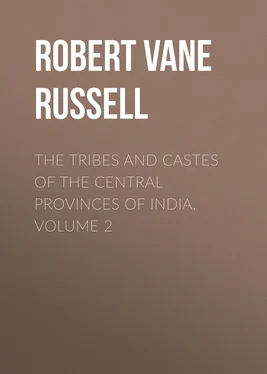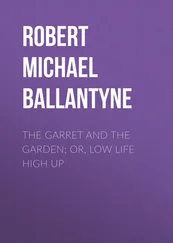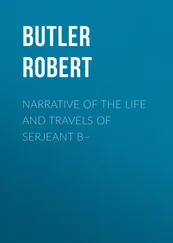Robert Vane Russell - The Tribes and Castes of the Central Provinces of India, Volume 2
Здесь есть возможность читать онлайн «Robert Vane Russell - The Tribes and Castes of the Central Provinces of India, Volume 2» — ознакомительный отрывок электронной книги совершенно бесплатно, а после прочтения отрывка купить полную версию. В некоторых случаях можно слушать аудио, скачать через торрент в формате fb2 и присутствует краткое содержание. Жанр: foreign_prose, История, foreign_edu, foreign_antique, на английском языке. Описание произведения, (предисловие) а так же отзывы посетителей доступны на портале библиотеки ЛибКат.
- Название:The Tribes and Castes of the Central Provinces of India, Volume 2
- Автор:
- Жанр:
- Год:неизвестен
- ISBN:нет данных
- Рейтинг книги:4 / 5. Голосов: 1
-
Избранное:Добавить в избранное
- Отзывы:
-
Ваша оценка:
- 80
- 1
- 2
- 3
- 4
- 5
The Tribes and Castes of the Central Provinces of India, Volume 2: краткое содержание, описание и аннотация
Предлагаем к чтению аннотацию, описание, краткое содержание или предисловие (зависит от того, что написал сам автор книги «The Tribes and Castes of the Central Provinces of India, Volume 2»). Если вы не нашли необходимую информацию о книге — напишите в комментариях, мы постараемся отыскать её.
The Tribes and Castes of the Central Provinces of India, Volume 2 — читать онлайн ознакомительный отрывок
Ниже представлен текст книги, разбитый по страницам. Система сохранения места последней прочитанной страницы, позволяет с удобством читать онлайн бесплатно книгу «The Tribes and Castes of the Central Provinces of India, Volume 2», без необходимости каждый раз заново искать на чём Вы остановились. Поставьте закладку, и сможете в любой момент перейти на страницу, на которой закончили чтение.
Интервал:
Закладка:
2. Subdivisions.
Owing to the fact that with the transfer of the Sambalpur District, a considerable portion of the Agharias have ceased to be residents of the Central Provinces, it is unnecessary to give the details of their caste organisation at length. They have two subdivisions, the Bad or superior Agharias and the Chhote, Sarolia or Sarwaria, the inferior or mixed Agharias. The latter are a cross between an Agharia and a Gaur (Ahīr) woman. The Bad Agharias will not eat with or even take water from the others. Further local subdivisions are now in course of formation, as the Ratanpuria, Phuljharia and Raigarhia or those living round Ratanpur, Phuljhar and Raigarh. The caste is said to have 84 gotras or exogamous sections, of which 60 bear the title of Patel, 18 that of Nāik, and 6 of Chaudhri. The section names are very mixed, some being those of eponymous Brāhman gotras , as Sāndilya, Kaushik and Bhāradwāj; others those of Rājpūt septs, as Karchhul; while others are the names of animals and plants, as Barāh (pig), Baram (the pīpal tree), Nāg (cobra), Kachhapa (tortoise), and a number of other local terms the meaning of which has been forgotten. Each of these sections, however, uses a different mark for branding cows, which it is the religious duty of an Agharia to rear, and though the marks now convey no meaning, they were probably originally the representations of material objects. In the case of names whose meaning is understood, traces of totemism survive in the respect paid to the animal or plant by members of the sept which bears its name. This analysis of the structure of the caste shows that it was a very mixed one. Originally consisting perhaps of a nucleus of immigrant Rājpūts, the offspring of connections with inferior classes have been assimilated; while the story already quoted is probably intended to signify, after the usual Brāhmanical fashion, that the pedigree of the Agharias at some period included a Chamār.
3. Marriage customs.
Marriage within the exogamous section and also with first cousins is forbidden, though in some places the union of a sister’s son with a brother’s daughter is permitted. Child marriage is usual, and censure visits a man who allows an unmarried daughter to arrive at adolescence. The bridegroom should always be older than the bride, at any rate by a day. When a betrothal is arranged some ornaments and a cloth bearing the swastik or lucky mark are sent to the girl. Marriages are always celebrated during the months of Māgh and Phāgun, and they are held only once in five or six years, when all children whose matches can be arranged for are married off. This custom is economical, as it saves expenditure on marriage feasts. Colonel Dalton also states that the Agharias always employ Hindustāni Brāhmans for their ceremonies, and as very few of these are available, they make circuits over large areas, and conduct all the weddings of a locality at the same period. Before the marriage a kid is sacrificed at the bride’s house to celebrate the removal of her status of maidenhood. When the bridegroom arrives at the bride’s house he touches with his dagger the string of mango-leaves suspended from the marriage-shed and presents a rupee and a hundred betel-leaves to the bride’s sawāsin or attendant. Next day the bridegroom’s father sends a present of a bracelet and seven small earthen cups to the bride. She is seated in the open, and seven women hold the cups over her head one above the other. Water is then poured from above from one cup into the other, each being filled in turn and the whole finally falling on the bride’s head. This probably symbolises the fertilising action of rain. The bride is then bathed and carried in a basket seven times round the marriage-post, after which she is seated in a chair and seven women place their heads together round her while a male relative winds a thread seven times round the heads of the women. The meaning of this ceremony is obscure. The bridegroom makes his appearance alone and is seated with the bride, both being dressed in clothes coloured yellow with turmeric. The bridegroom’s party follows, and the feet of the couple are washed with milk. The bride’s brother embraces the bridegroom and changes cloths with him. Water is poured over the hands of the couple, the girl’s forehead is daubed with vermilion, and a red silk cloth is presented to her and the couple go round the marriage-post. The bride is taken for four days to the husband’s house and then returns, and is again sent with the usual gauna ceremony, when she is fit for conjugal relations. No price is usually paid for the bride, and each party spends about Rs. 100 on the marriage ceremony. Polygamy and widow marriage are generally allowed, the widow being disposed of by her parents. The ceremony at the marriage of a widow consists in putting vermilion on the parting of her hair and bangles on her wrists. Divorce is allowed on pain of a fine of Rs. 50 if the divorce is sought by the husband, and of Rs. 25 if the wife asks for it. In some localities divorce and also polygamy are said to be forbidden, and in such cases a woman who commits adultery is finally expelled from the caste, and a funeral feast is given to symbolise her death.
4. Religious and social customs.
The family god of the Agharias is Dulha Deo, who exists in every household. On the Haraiti day or the commencement of the agricultural year they worship the implements of cultivation, and at Dasahra the sword if they have one. They have a great reverence for cows and feed them sumptuously at festivals. Every Agharia has a guru or spiritual guide who whispers the mantra or sacred verse into his ear and is occasionally consulted. The dead are usually burnt, but children and persons dying of cholera or smallpox are buried, males being placed on the pyre or in the grave on their faces and females on their backs, with the feet pointing to the south. On the third day the ashes are thrown into a river and the bones of each part of the body are collected and placed under the pipal tree, while a pot is slung over them, through which water trickles continually for a week, and a lighted lamp, cooked food, a leaf-cup and a tooth-stick are placed beside them daily for the use of the deceased during the same period. Mourning ends on the tenth day, and the usual purification ceremonies are then performed. Children are mourned for a shorter period. Well-to-do members of the caste feed a Brāhman daily for a year after a death, believing that food so given passes to the spirit of the deceased. On the anniversary of the death the caste-fellows are feasted, and after that the deceased becomes a purkha or ancestor and participates in devotions paid at the shrādhh ceremony. When the head of a joint family dies, his successor is given a turban and betel-leaves, and his forehead is marked by the priest and other relations with sandalwood. After a birth the mother is impure for twenty-one days. A feast is given on the twelfth day, and sometimes the child is named then, but often children are not named until they are six years old. The names of men usually end in Ram , Nāth or Singh , and those of women in Kunwar . Women do not name their husbands, their elderly relations, nor the sons of their husband’s eldest brother. A man does not name his wife, as he thinks that to do so would tend to shorten his life in accordance with the Sanskrit saying, ‘He who is desirous of long life should not name himself, his guru , a miser, his eldest son, or his wife.’ The Agharias do not admit outsiders into the caste. They will not take cooked food from any caste, and water only from a Gaur or Rāwat. They refuse to take water from an Uriya Brāhman, probably in retaliation for the refusal of Uriya Brāhmans to accept water from an Agharia, though taking it from a Kolta. Both the Uriya Brāhmans and Agharias are of somewhat doubtful origin, and both are therefore probably the more concerned to maintain the social position to which they lay claim. But Kewats, Rāwats, Telis and other castes eat cooked food from Agharias, and the caste therefore is admitted to a fairly high rank in the Uriya country. The Agharias do not drink liquor or eat any food which a Rājpūt would refuse.
Читать дальшеИнтервал:
Закладка:
Похожие книги на «The Tribes and Castes of the Central Provinces of India, Volume 2»
Представляем Вашему вниманию похожие книги на «The Tribes and Castes of the Central Provinces of India, Volume 2» списком для выбора. Мы отобрали схожую по названию и смыслу литературу в надежде предоставить читателям больше вариантов отыскать новые, интересные, ещё непрочитанные произведения.
Обсуждение, отзывы о книге «The Tribes and Castes of the Central Provinces of India, Volume 2» и просто собственные мнения читателей. Оставьте ваши комментарии, напишите, что Вы думаете о произведении, его смысле или главных героях. Укажите что конкретно понравилось, а что нет, и почему Вы так считаете.












